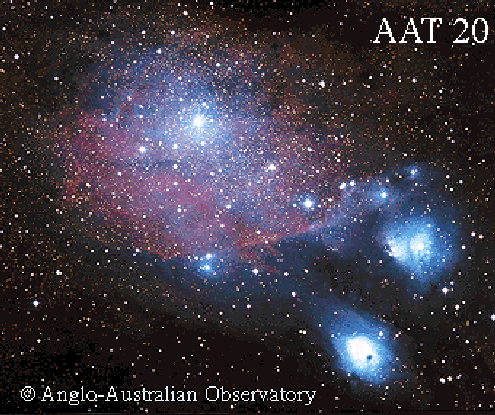Astronomy Picture of the Day
Discover the cosmos!
Each day a different image or photograph of our fascinating universe is
featured, along with a brief explanation written by a professional
astronomer.
July 18, 1996

Nebulosity in Sagittarius
Credit:
Anglo-Australian Telescope
photograph by David Malin
Copyright:
Anglo-Australian Telescope
Board
Explanation:
What causes the colors in this beautiful nebulosity in Sagittarius?
Dubbed NGC 6589 and NGC 6590,
the colors of this nebulosity,
are caused by gas and
dust.
The blue color of the nebula nearest the bright stars is caused by reflection off interstellar dust. The dust emits little visible
light of its own - in the absence of a nearby star the dust would appear
dark, blocking light from
background stars. The red color of the
nebula farthest from the bright stars is caused by glowing hydrogen gas.
Energetic light
from the central stars ionizes
hydrogen gas -
which glows red when recombining with a local electron. In the absence of
a nearby star, the gas would neither glow on its own nor absorb much
background starlight.
Tomorrow's picture: Galileo's First Color Image of Io
| Archive
| Index
| Search
| Glossary
| Education
| About APOD |




Authors & editors:
Robert Nemiroff
(MTU) &
Jerry
Bonnell (USRA).
NASA Technical Rep.:
Sherri
Calvo.
Specific rights apply.
A service of:
LHEA
at
NASA/
GSFC




